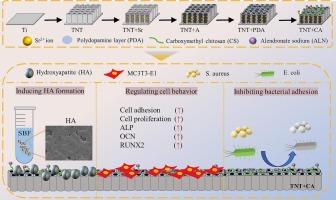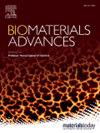羧甲基壳聚糖/阿仑膦酸钠/Sr2+修饰的二氧化钛纳米管阵列可增强成骨活性和抗菌性能。
IF 5.5
2区 医学
Q2 MATERIALS SCIENCE, BIOMATERIALS
Materials Science & Engineering C-Materials for Biological Applications
Pub Date : 2024-11-06
DOI:10.1016/j.bioadv.2024.214107
引用次数: 0
摘要
钛及其合金具有良好的机械性能和优异的耐腐蚀性,因此被广泛用作骨科植入物。然而,成骨活性和抗菌性能不足阻碍了它们的临床应用。为了解决这些问题,首先通过阳极氧化技术在 TA2 合金表面制造了二氧化钛纳米管阵列(TNT),然后通过水热反应(TNT + Sr)和退火处理(TNT + A)将锶离子(Sr2+)加入其中。随后,通过构建聚多巴胺层(TNT + PDA)来固定羧甲基壳聚糖和阿仑膦酸钠混合物(TNT + CA)。通过扫描电子显微镜(SEM)、能量色散光谱仪(EDS)、X 射线光电子能谱仪(XPS)、衰减全反射-傅立叶变换红外光谱仪(ATR-FTIR)、X 射线衍射仪(XRD)和水接触角测量对制备的涂层进行了全面表征。结果证实,Sr2+ 离子、聚多巴胺和羧甲基壳聚糖/阿仑膦酸钠被成功固定在纳米管上。TNT + CA涂层显著增强了亲水性,并有效延缓了Sr2+和阿仑膦酸钠的释放。TNT + CA涂层能明显促进成骨细胞的粘附和增殖,并上调碱性磷酸酶(ALP)、骨钙素(OCN)和成骨细胞特异性转录因子(RUNX2)的表达。TNT + CA能快速诱导模拟体液(SBF)中羟基磷灰石的原位沉积。此外,TNT + CA涂层对大肠杆菌和金黄色葡萄球菌(尤其是大肠杆菌)有抑制作用。制备的 TNT + CA 涂层为增强钛基生物材料的骨亲和性、改善成骨细胞行为和抗菌性能提供了一种新策略。本文章由计算机程序翻译,如有差异,请以英文原文为准。

Carboxymethyl chitosan/alendronate sodium/Sr2+ modified TiO2 nanotube arrays enhancing osteogenic activity and antibacterial property
Titanium and its alloys are widely used as orthopedic implants owing to their good mechanical properties and excellent corrosion resistance. However, the insufficient osteogenic activity and antibacterial properties hinder their clinical applications. To address these issues, TiO2 nanotube arrays (TNT) were first fabricated on the TA2 alloy surface via an anodizing technique, and strontium ions (Sr2+) were then loaded by hydrothermal reaction (TNT + Sr) and annealing treatment (TNT + A). Subsequently, the polydopamine layer (TNT + PDA) was constructed to immobilize the carboxymethyl chitosan and alendronate sodium (TNT + CA) mixture. The prepared coatings were thoroughly characterized by scanning electron microscopy (SEM), energy dispersive spectrometer (EDS), X-ray photoelectron spectrometer (XPS), attenuated total reflection-Fourier transform infrared spectroscopy (ATR-FTIR), X-ray diffractometer (XRD), and water contact angle measurement. The results confirmed that Sr2+ ions, polydopamine, and carboxymethyl chitosan/alendronate sodium were successfully immobilized on the nanotubes. The coating of TNT + CA significantly enhanced the hydrophilicity, and effectively delayed the release of Sr2+ and alendronate. The TNT + CA coating significantly promoted osteoblast adhesion and proliferation, and up-regulated the expressions of alkaline phosphatase (ALP), osteocalcin (OCN), and osteoblast-specific transcription factor (RUNX2). TNT + CA was able to rapidly induce in situ hydroxyapatite deposition from the simulated body fluid (SBF). Moreover, TNT + CA coating showed inhibition against Escherichia coli and Staphylococcus aureus (especially against Escherichia coli). The prepared TNT + CA coating provides a novel strategy for enhancing bone affinity, improving osteoblast behaviors, and antibacterial properties of titanium-based biomaterials.
求助全文
通过发布文献求助,成功后即可免费获取论文全文。
去求助
来源期刊
CiteScore
17.80
自引率
0.00%
发文量
501
审稿时长
27 days
期刊介绍:
Biomaterials Advances, previously known as Materials Science and Engineering: C-Materials for Biological Applications (P-ISSN: 0928-4931, E-ISSN: 1873-0191). Includes topics at the interface of the biomedical sciences and materials engineering. These topics include:
• Bioinspired and biomimetic materials for medical applications
• Materials of biological origin for medical applications
• Materials for "active" medical applications
• Self-assembling and self-healing materials for medical applications
• "Smart" (i.e., stimulus-response) materials for medical applications
• Ceramic, metallic, polymeric, and composite materials for medical applications
• Materials for in vivo sensing
• Materials for in vivo imaging
• Materials for delivery of pharmacologic agents and vaccines
• Novel approaches for characterizing and modeling materials for medical applications
Manuscripts on biological topics without a materials science component, or manuscripts on materials science without biological applications, will not be considered for publication in Materials Science and Engineering C. New submissions are first assessed for language, scope and originality (plagiarism check) and can be desk rejected before review if they need English language improvements, are out of scope or present excessive duplication with published sources.
Biomaterials Advances sits within Elsevier''s biomaterials science portfolio alongside Biomaterials, Materials Today Bio and Biomaterials and Biosystems. As part of the broader Materials Today family, Biomaterials Advances offers authors rigorous peer review, rapid decisions, and high visibility. We look forward to receiving your submissions!

 求助内容:
求助内容: 应助结果提醒方式:
应助结果提醒方式:


